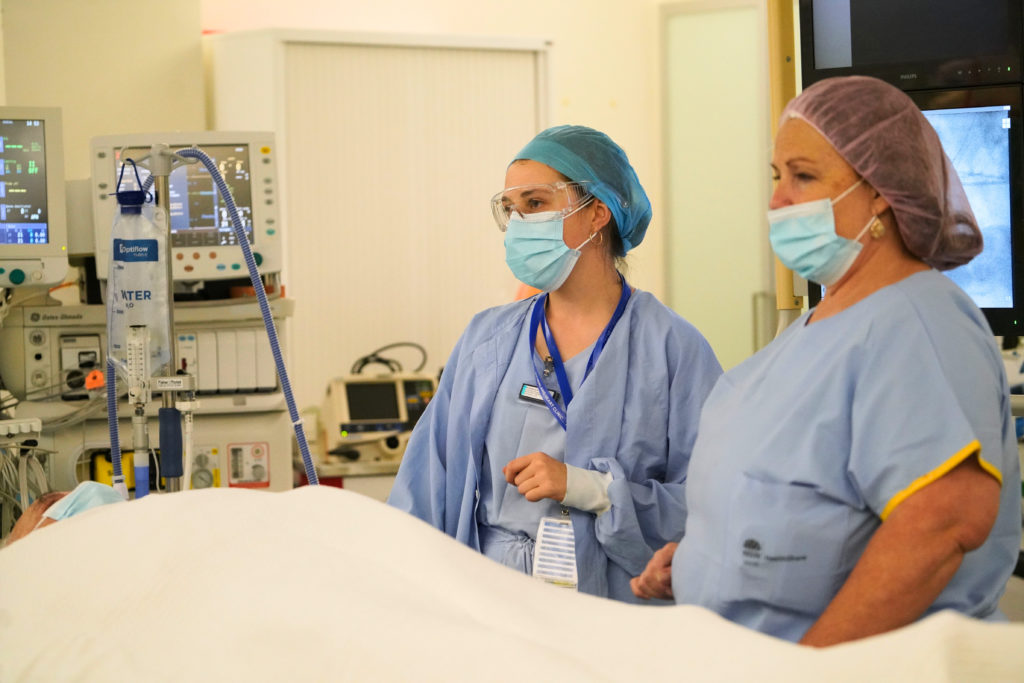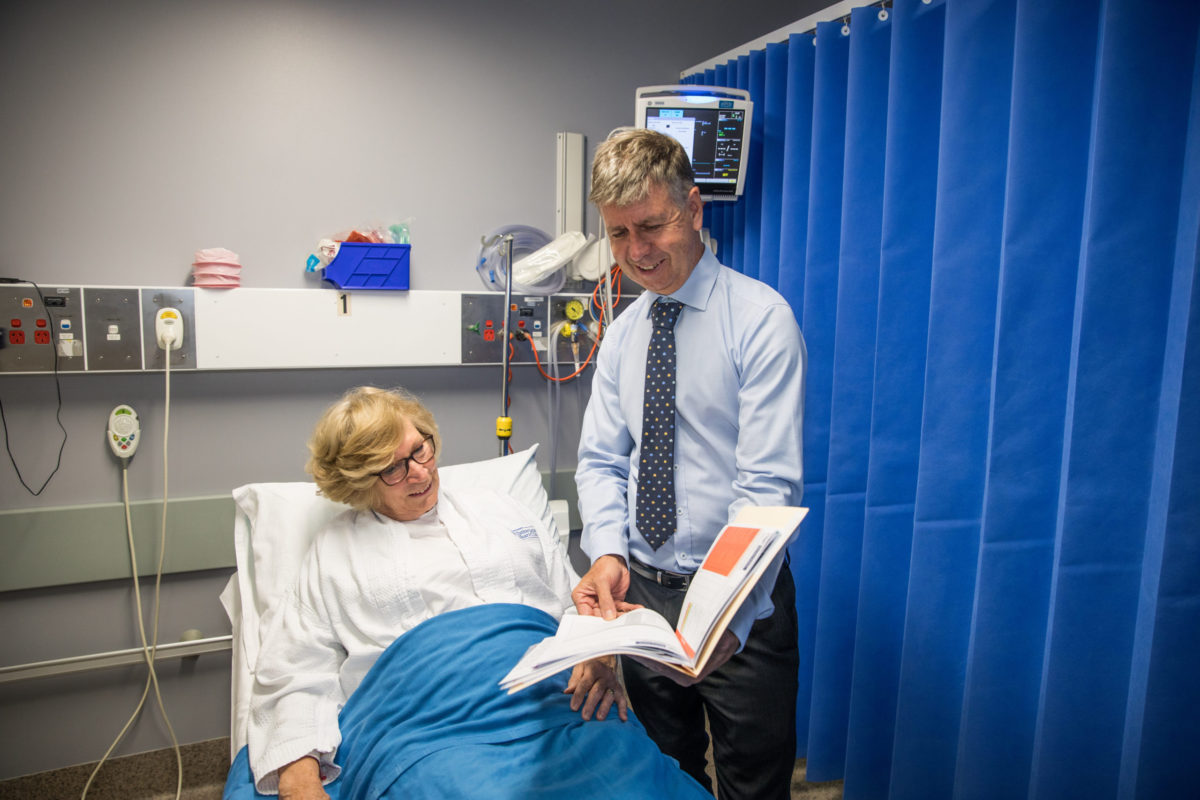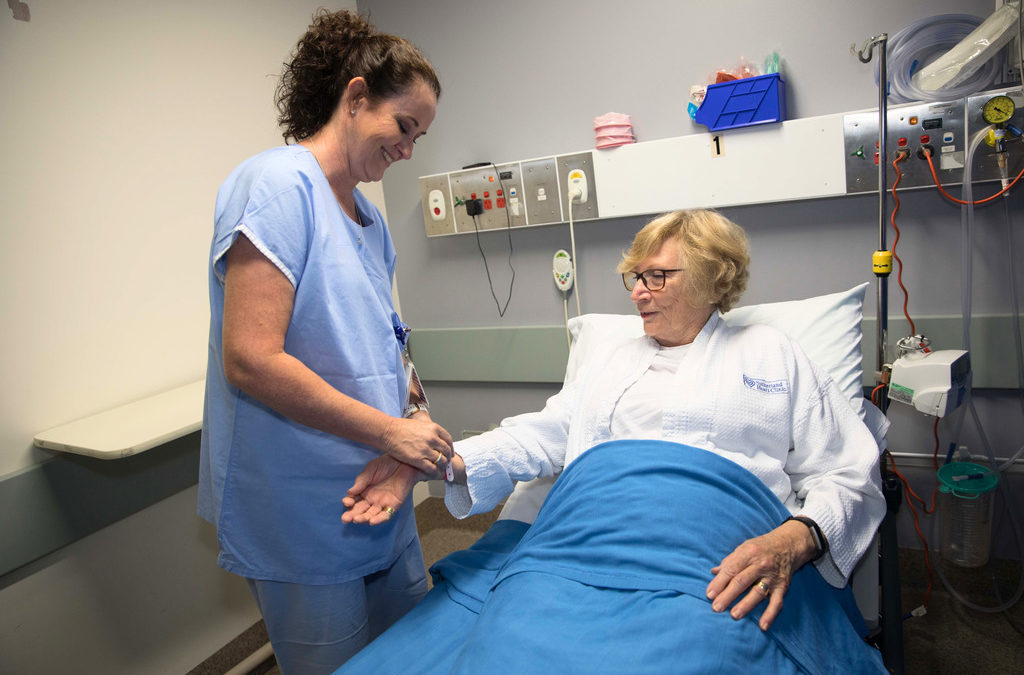A coronary angiogram is a common procedure that can also be known as an angiogram, coronary angiography, cardiac catheterisation or even just as an “angio”.
Heart disease is still the leading cause of death in Australia, despite ongoing improvements in prevention, education and treatment.
If you’ve had a heart attack, angina or unexplained chest pain, you might be referred by your GP to a cardiologist to be assessed for a coronary angiogram.
We’ve prepared this complete patient guide to coronary angiograms, which covers what it is, why it’s needed and what happens before, during and after the procedure. If you need any further information, please discuss this with your GP or cardiologist.
Coronary angiogram: What is it and why is it needed?
A coronary angiogram is a common procedure that involves taking X-ray images of the blood vessels leading to the heart. It gives your doctor a clear picture of your heart and its surrounding arteries, helping to diagnose any underlying heart condition and to help determine what treatment is needed.
The coronary arteries surround the heart and supply the heart muscle with vital blood to keep it pumping. If fatty plaque builds up and clogs your arteries, it can restrict blood flow to the heart. Poor blood flow can cause potentially life-threatening problems such angina, heart attack or heart failure.
A coronary angiogram helps to identify any narrowing or blockages in the arteries leading to the heart and shows whether blood flow is being restricted. If there’s a problem it will show exactly which arteries are narrowed, and the severity of any blockages.
“If your doctor is concerned about your heart and suspects that you might have narrowing of the coronary arteries, they might recommend that you have an angiogram,” Sutherland Heart Clinic Medical Director Dr Mark Pitney said.
“An angiogram is a very common procedure that shows whether any of the coronary arteries are narrowed or blocked by plaque, so your doctor can effectively manage it.
“If you have any narrowing of the coronary arteries, it’s important to get that diagnosed early so it can be treated, because undiagnosed coronary artery disease can put you at risk of a heart attack,” he said.
What are the potential risks of having a coronary angiogram?
An angiogram is a common procedure that’s performed regularly at Sutherland Heart Clinic.
The most common side effect of the procedure is some bruising and/or swelling at the site where the catheter was inserted.
Like all surgical procedures, coronary angiograms do carry some risk – however the overall risk of complications is low. Potential risks, which are generally uncommon, include:
- an allergic reaction to the X-ray dye
- infection
- bleeding
- pain
- abnormal heart rhythms (arrhythmias)
- heart attack
- stroke
- damage to the kidneys
- damage to the arteries
Every case is different, so relative risks of the procedure are always discussed with patients by their attending doctor beforehand.
What happens before your procedure

Before you book in to have your angiogram at Sutherland Heart Clinic, your doctor will explain what happens during the procedure and answer any questions you might have. You’ll then need to sign a consent form.
If you’re taking certain medications such as Warfarin, Lasix or insulin, your doctor will advise you if you need to stop or change any medications. Warfarin, for instance, may need to be stopped three days before an angiogram. You may also need to take a different type of anticoagulant (blood thinner).
“It’s very important not to stop taking any medication until you’ve talked to your doctor,” Dr Pitney says.
“Your doctor will give you advice on whether you need to stop taking medication, when to stop taking it, and when you can start again after the procedure.
“Our nursing staff will also provide you with some additional information on your medications before your admission.”
Fasting before your procedure
You’ll be required to fast before your coronary angiogram procedure. The details of your fasting will be determined by the time of your procedure. But as a general rule, you’ll be asked to stop eating solid food six hours before your admission. You can have clear fluids at that time, but no cloudy or milky drinks.
You’ll then be asked to stop drinking fluids two hours before admission. That means you can’t have any clear fluids past that time, including water.
These are the general fasting guidelines we use at Sutherland Heart Clinic. No matter where you’re having your procedure, you’ll be given instructions specific to your doctor or clinic prior to admission. If you have any questions, please contact your doctor or clinic beforehand.
How long the procedure takes and what to bring on the day
Patients attending Sutherland Heart Clinic for a coronary angiogram can generally expect to be at the clinic for about eight hours in total, from the time of your arrival to the time of your departure.
We recommend you pack a small bag with a few essentials, including:
- your current medications
- any recent pathology, blood results or X-rays
- referral letters
- your health insurance details
- Medicare card and Veterans Affairs details (if applicable)
- worker’s compensation details (if applicable)
- something to pass the time while you wait, such as reading material, knitting or crosswords, along with your reading glasses
- and a few toiletries
What happens during a coronary angiogram
When you arrive for your procedure you will be greeted by our friendly admin and nursing staff, and be asked to change into a hospital gown.
In the pre-operative area, an experienced nurse will go through your medical history and perform some basic observations. A “drip” for intravenous therapy will be inserted as you are likely to receive fluids before the procedure and sedation during the procedure.
You will then be taken into a cardiac catheter laboratory, which looks like an operating room.
You will be awake and lying down on a narrow table for your procedure, and be cared for by doctors and nurses. Usually, 3 or 4 people will be in the room to look after you.
Usually, some intravenous sedation is given to make you really comfortable and a bit “dozy” but you will not be given a full anaesthetic.
A small amount of local anaesthetic at the site where the catheter (a thin, flexible hollow tube) will be inserted is then used. Note that in the majority of cases, an angiogram causes very little, if any, pain or distress so if you are uncomfortable, you must tell the doctor.
During the procedure, a short plastic tube with a valve is inserted into an artery in your wrist or groin. Your doctor will choose the site that’s best for you.
Catheters are then guided through this insertion site over a wire into your heart and coronary arteries using X-ray.
A liquid iodine-based contrast agent (X-ray dye) is then injected through the catheter to visualise the arteries. Usually, you will not feel anything when that occurs.
During the angiogram, the valves on the left side of the heart and the pumping chamber may also be checked for any abnormalities. If a picture is taken of the main pumping chamber, you may feel a warm sensation lasting 10 seconds.
At the end of the procedure, the catheter is removed, and pressure is applied to the site where it was inserted. If the procedure was performed via the groin, a “closure device” (stitch or plug) may be inserted.
The procedure normally takes about 30 minutes.
You will then be taken through to our 10-bed recovery room, where you’ll be cared for and closely monitored by our experienced recovery room nursing staff.
After your angiogram
Depending on where the catheter was inserted, you may need to lie still for two to six hours in recovery to make sure the wound is sealed and to minimise any bleeding.
Where possible, your doctor will visit you while you’re in recovery and update you on the procedure and its findings.
Once you’re feeling well recovered, you may be moved into a supervised area of the recovery room where you can sit in a comfortable chair and have something light to eat and drink.
Once you’re ready to leave, the intravenous needle will be removed, and you can get dressed.
You shouldn’t drive yourself home, so make sure you’ve arranged for someone to take you home. If you live alone, we recommend having someone stay with you for the first night just in case you need some help or support.

Recovering at home
Once you’re at home, keep the bandage on and avoid showering for 24 hours afterwards. You can use an ice pack on the puncture site if needed to reduce pain and swelling.
Your doctor will let you know when to start taking your medication again, such as blood thinners.
Don’t do any strenuous exercise for a few days after the procedure and avoid taking a bath for one week.
Drink lots of fluids (such as water) to help flush out the dye, and eat a healthy diet with lots of vegetables, fruit and whole grains.
Contact your angiogram clinic straight away if you experience:
- any chest pain or tightness
- fever
- swelling or bleeding where the catheter was inserted
- any weakness or numbness in the limb where the catheter was inserted
Call an ambulance immediately if you experience:
- significant bleeding or swelling of the wound
- chest pain or tightness that increases or is severe
If you have any general questions or concerns about your recovery when you’re at home, you should contact your doctor’s rooms or ring your angiogram clinic for advice.
About Sutherland Heart Clinic
Sutherland Heart Clinic is a major interventional cardiology centre co-located within Sutherland Hospital at Caringbah in Sydney’s southern suburbs. The clinic offers a wide range of procedures including diagnostic studies, angioplasty procedures (with stents) and pacemaker procedures.
Learn more about our clinic, cardiology procedures, and what to expect if you’ll be visiting us for a procedure.
Read more:
What is an angiogram?
Day of the procedure
Before your visit
After your visit
Patient privacy and rights


Recent Comments